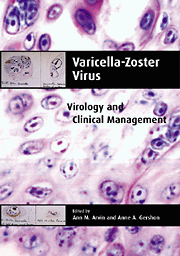Book contents
- Frontmatter
- Contents
- List of contributors
- Preface
- Introduction
- Part I History
- Part II Molecular Biology and Pathogenesis
- Part III Epidemiology and Clinical Manifestations
- Part IV Laboratory Diagnosis
- Part V Treatment and Prevention
- 18 Treatment of varicella
- 19 Treatment of herpes zoster
- 20 Management of postherpetic pain
- 21 Passive antibody prophylaxis
- 22 Development of the Oka vaccine
- 23 Primary immunization against varicella
- 24 Prevention of nosocomial transmission
- 25 Immunization against herpes zoster
- Index
- Plate section
22 - Development of the Oka vaccine
from Part V - Treatment and Prevention
Published online by Cambridge University Press: 02 March 2010
- Frontmatter
- Contents
- List of contributors
- Preface
- Introduction
- Part I History
- Part II Molecular Biology and Pathogenesis
- Part III Epidemiology and Clinical Manifestations
- Part IV Laboratory Diagnosis
- Part V Treatment and Prevention
- 18 Treatment of varicella
- 19 Treatment of herpes zoster
- 20 Management of postherpetic pain
- 21 Passive antibody prophylaxis
- 22 Development of the Oka vaccine
- 23 Primary immunization against varicella
- 24 Prevention of nosocomial transmission
- 25 Immunization against herpes zoster
- Index
- Plate section
Summary
Varicella vaccine, the first vaccine licensed against a human herpes virus, took many years to develop. A number of difficulties had to be overcome: skepticism about medical need, difficulties in consistency of production, and doubts about its safety and efficacy. However, it is a success story and is worth recounting. This chapter focuses on the conception of the vaccine by M. Takahashi, its developer, its characterization, the difficulties in overcoming American objections to the vaccine, and the first 10 to 12 years of development (1974–84).
The background to development of the Oka vaccine, as recounted by Takahashi
Experience of attenuation of measles and polioviruses
In 1959–1962, I worked on development of attenuated live measles vaccines. This virus was attenuated by passage in the amniotic cavity and chorioallantoic membrane of developing chick embryos. In addition to the work with measles virus, I worked on adaptation of poliovirus type 3 to chick embryo cells. As is well known, poliovirus type 2 grows well in developing chick embryo cells, but types 1 and 3 do not. Attempts to adapt type 3 poliovirus to chick embryo cells by alternate passage in chick embryo cells and monkey kidney cells failed. No continuous growth of poliovirus type 3 took place in chick embryo cells. However, after several alternate passages the virus was found to be remarkably thermosensitive, growing to low titers at 34 °C and less neurovirulent.
These studies demonstrated that passage in foreign-species cells is a convenient and effective means by which to attenuate viruses for use as live virus vaccines.
- Type
- Chapter
- Information
- Varicella-Zoster VirusVirology and Clinical Management, pp. 442 - 459Publisher: Cambridge University PressPrint publication year: 2000
- 4
- Cited by



